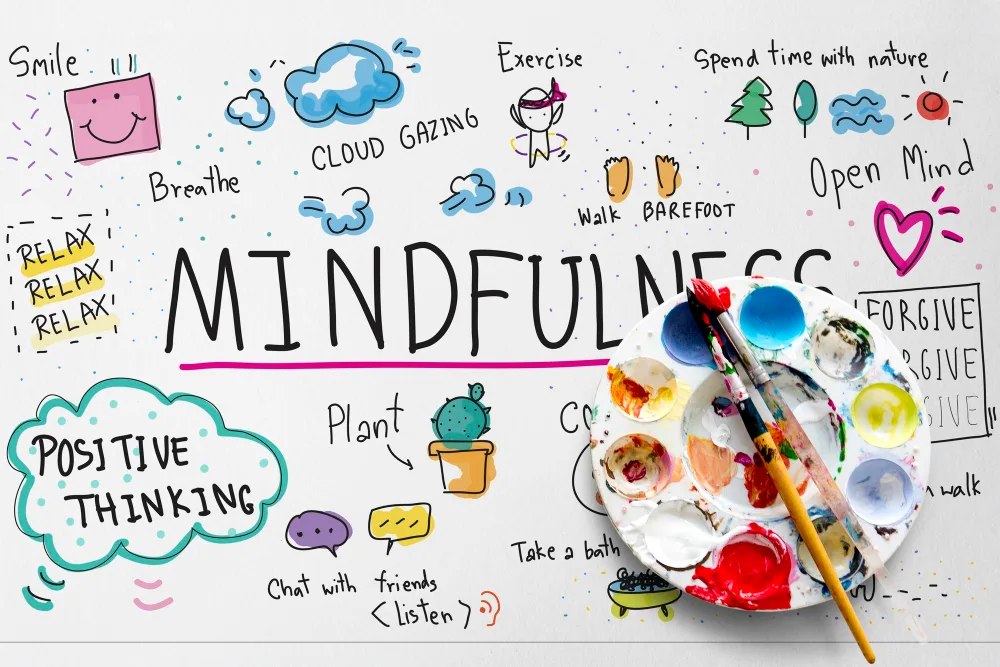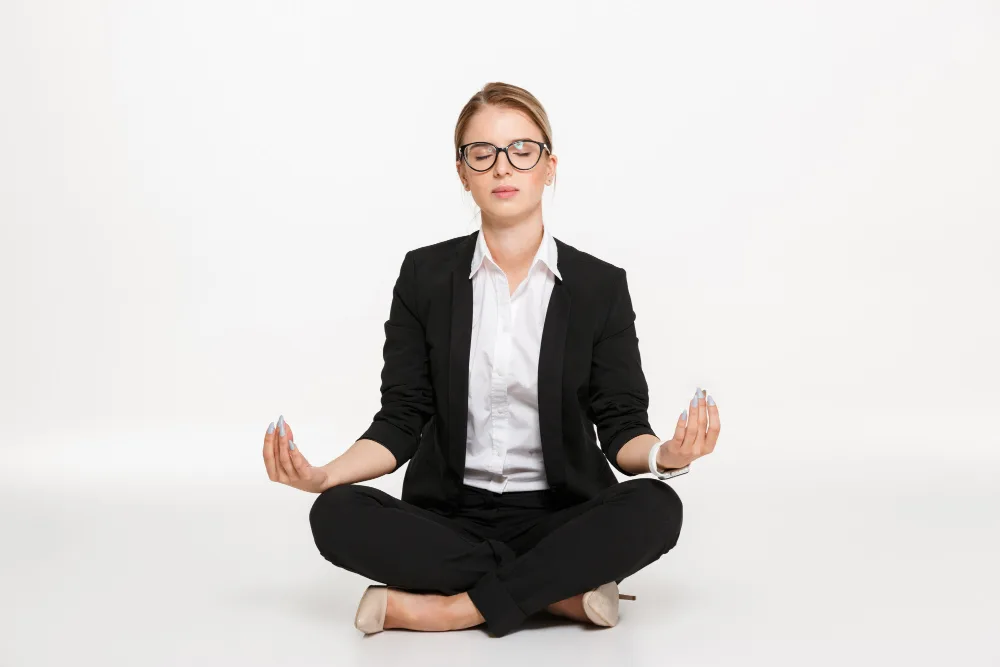Have you ever felt overwhelmed by the constant buzz of daily life? I know I have. That’s where guided meditation comes in—a practice that has transformed countless lives, including my own. Guided meditation is like having a personal coach for your mind, leading you through a journey of relaxation and self-discovery without the pressure of “doing it right.”
In this article, I’ll walk you through everything you need to know about guided meditation—what it is, how it works, and why it might be exactly what you need in your life right now. Whether you’re a complete beginner or looking to deepen your practice, you’ll find valuable insights that can help you harness the transformative power of this ancient yet modern practice.
What Is Guided Meditation and How Does It Work?

Guided meditation is a form of meditation where you follow the verbal instructions of a teacher, guide, or narrator. Unlike silent meditation where you’re left to your own devices, guided meditation provides a framework and direction for your practice.
Think of it as having a trusted friend taking you by the hand through unfamiliar territory. Your guide will help you navigate your thoughts, direct your focus, and lead you toward a state of relaxation and mindfulness.
The process typically involves:
- Finding a comfortable position
- Listening to a soothing voice guiding your attention
- Following instructions for breathing and visualization
- Being led through specific scenarios or body awareness exercises
What makes guided meditation unique is that it bridges the gap between traditional meditation practices and our modern, often distracted minds. It provides structure for those who find it challenging to sit in silence with their thoughts.
“Guided meditation is like training wheels for your mind—it gives you the support you need until you’re ready to ride on your own,” as one meditation teacher aptly puts it.
10 Powerful Benefits of Guided Meditation

Guided meditation offers a wealth of benefits that extend far beyond the meditation cushion. Here’s how this practice can transform various aspects of your life:
1. Stress and Anxiety Reduction
One of the most immediate benefits of guided meditation is its ability to activate your body’s relaxation response. Research has shown that regular practice can lower cortisol levels—your body’s primary stress hormone.
When you follow a guide’s calming voice, your nervous system shifts from “fight or flight” mode to “rest and digest,” providing much-needed relief from chronic stress and anxiety.
2. Improved Sleep Quality
If you’ve ever found yourself staring at the ceiling at 2 AM, guided meditation might be your ticket to dreamland. Sleep-focused guided meditations help quiet the mental chatter that keeps you awake.
By guiding you through progressive relaxation techniques and soothing visualizations, these meditations prepare your body and mind for restful sleep. Many practitioners report falling asleep faster and experiencing deeper, more restorative rest.
3. Enhanced Focus and Clarity
In our age of constant notifications and distractions, attention has become a precious resource. Regular guided meditation strengthens your “attention muscle,” making it easier to stay present and focused throughout your day.
The practice of gently returning your attention to the guide’s voice whenever your mind wanders builds neural pathways that support sustained concentration. Over time, you’ll notice improved productivity and clearer thinking.
4. Emotional Regulation
Guided meditation creates space between your emotions and your reactions to them. Through consistent practice, you develop the ability to observe your feelings without being overwhelmed by them.
This emotional resilience is particularly valuable during challenging times. As you become more attuned to your inner landscape, you’ll respond rather than react to emotional triggers.
5. Lowered Blood Pressure
The relaxation induced by guided meditation can have measurable effects on your physical health. Regular practitioners often experience reduced blood pressure and improved heart health.
These physiological benefits stem from the practice’s ability to activate the parasympathetic nervous system, which counteracts the stress response that contributes to hypertension.
6. Increased Self-Awareness
Guided meditation often includes prompts that encourage self-reflection and inner exploration. These exercises help you connect with your authentic self and understand your patterns of thought and behavior.
This heightened self-awareness can lead to personal growth and more intentional living. You might discover insights about yourself that would have remained hidden in the busy-ness of everyday life.
7. Pain Management
For those dealing with chronic pain, guided meditation offers a complementary approach to traditional treatments. Pain-focused meditations help you change your relationship with physical discomfort.
By directing your attention and altering your perception of pain signals, these practices can provide significant relief. Many pain management centers now incorporate guided meditation into their treatment protocols.
8. Improved Digestion
The gut-brain connection is powerful, and stress can wreak havoc on your digestive system. By activating your body’s relaxation response, guided meditation can alleviate digestive issues related to stress.
Many people notice reduced symptoms of irritable bowel syndrome (IBS) and other stress-related digestive complaints after incorporating regular meditation into their routines.
9. Boosted Immune Function
Emerging research suggests that mindfulness practices like guided meditation may enhance immune function. By reducing stress hormones that can suppress immune activity, meditation creates conditions for optimal physical health.
Regular practitioners may experience fewer colds and infections, and some studies suggest meditation can support recovery from illness.
10. Greater Compassion and Connection
Many guided meditations incorporate loving-kindness or compassion exercises. These practices expand your capacity for empathy—both toward yourself and others.
As you develop greater self-compassion, you’ll likely find your relationships improving. The inner peace cultivated through meditation tends to radiate outward, creating more harmonious connections with those around you.
How to Begin Your Guided Meditation Practice: A Step-by-Step Guide

Starting a meditation practice doesn’t have to be complicated. Here’s a simple approach to begin your guided meditation journey:
1. Create Your Sacred Space
While you can meditate anywhere, having a dedicated space can enhance your practice. Choose a quiet corner where you won’t be disturbed. Add elements that promote relaxation—perhaps a cushion, a candle, or a plant.
Your space doesn’t need to be elaborate; the key is that it feels inviting and comfortable to you. Even a corner of your bedroom can serve as your meditation sanctuary.
2. Choose the Right Type of Guided Meditation
With countless options available, finding the right guided meditation for your needs is important. Here are some popular types to consider:
- Body scan meditations: Great for physical relaxation and connecting with your body
- Visualization exercises: Help manifest goals or create inner calm through imagery
- Breathing-focused practices: Excellent for beginners and stress relief
- Loving-kindness meditations: Develop compassion for yourself and others
- Sleep meditations: Designed specifically to help you drift off to sleep
Start with shorter sessions (5-10 minutes) and gradually increase the duration as you become more comfortable with the practice.
3. Find Your Guide
The voice guiding your meditation can significantly impact your experience. Some people prefer a soft, gentle tone, while others respond better to a more grounded, authoritative guide.
Explore different teachers and apps until you find voices that resonate with you. Many platforms offer sample meditations so you can “test drive” different guides before committing.
4. Set a Regular Schedule
Consistency is key to experiencing the benefits of guided meditation. Schedule your practice at the same time each day to establish a habit.
Many people find that meditating first thing in the morning helps set a positive tone for the day, while others prefer evening sessions to unwind and process the day’s events.
5. Prepare Your Body
Before beginning your meditation, take a moment to prepare physically:
- Use the restroom if needed
- Wear comfortable clothing
- Consider having water nearby
- Silence your phone and notifications
- Find a position that you can maintain comfortably
Remember that meditation doesn’t require perfect lotus posture—sitting in a chair or even lying down (if you’re not likely to fall asleep) are perfectly valid options.
6. Approach with Curiosity
Enter each meditation session with an attitude of curiosity rather than expectation. Some days your mind will be relatively quiet; other days, it might feel like a monkey swinging from branch to branch.
Both experiences are normal and valuable parts of the practice. The goal isn’t to achieve a particular state but to build awareness of whatever is present.
7. Be Patient and Persistent
Like any skill, meditation takes time to develop. If you find your mind wandering constantly during your first sessions, you’re not failing—you’re meditating! The practice is in noticing the wandering and gently returning to your guide’s voice.
Commit to at least two weeks of regular practice before evaluating its effects on your life. Many benefits accrue gradually over time.
Popular Guided Meditation Techniques for Different Needs

Guided meditation isn’t one-size-fits-all. Different techniques serve different purposes. Here’s a breakdown of popular approaches and when to use them:
For Stress Relief: Progressive Relaxation
Progressive relaxation guides you through tensing and releasing muscle groups throughout your body. This technique physically releases the tension we unconsciously hold and teaches your body to recognize the difference between tension and relaxation.
When to use it: After a stressful day, during lunch breaks, or whenever you feel physically tense.
For Sleep: Body Scan Meditation
Body scan meditations direct your attention systematically through different parts of your body, promoting deep relaxation. These practices often incorporate breathing techniques and visualizations that prepare your body and mind for sleep.
When to use it: 15-30 minutes before bedtime as part of your wind-down routine.
For Focus: Breath Awareness
These meditations train your attention by using your breath as an anchor. Your guide will direct you to notice the sensations of breathing—perhaps the feeling of air passing through your nostrils or the rising and falling of your chest.
When to use it: Before starting work requiring concentration, during study sessions, or whenever you need to center yourself.
For Emotional Balance: Loving-Kindness Meditation
Also known as Metta meditation, this practice involves mentally sending goodwill, kindness, and warmth toward others by silently repeating phrases such as “May you be happy, may you be healthy, may you be safe.”
When to use it: During times of conflict, when feeling isolated, or to cultivate greater compassion generally.
For Creativity: Visualization Journeys
These guided meditations take you on imaginative journeys to stimulate creativity and access your subconscious mind. You might be led through forests, along beaches, or into magical spaces that inspire new perspectives.
When to use it: Before creative work, when problem-solving, or whenever you feel stuck.
Top Tools and Resources for Guided Meditation
The right resources can transform your meditation experience. Here are some excellent options to explore:
Mobile Apps
Mobile apps make guided meditation accessible anywhere, anytime. Here are some standout options:
- Calm App – Offers a wide range of guided meditations for sleep, stress relief, and mindfulness, suitable for all levels.
- Headspace App – Provides structured courses and daily meditations with expert guidance.
- Insight Timer App – Features thousands of free guided meditations and talks by experts.
- AURA App – Personalized mindfulness app with meditations tailored to user preferences.
- Breethe App – Combines guided meditations with sleep aids and wellness coaching.
Audio Resources
For those who prefer audio-only experiences:
- The Honest Guys Guided Meditations – Offers audio-based meditations focusing on relaxation and visualization.
- Guided Meditations by Deepak Chopra – Audio series focusing on spiritual growth and relaxation.
- Yoga Nidra Guided Meditations by Swami Satyananda Saraswati – Deep relaxation audio sessions based on ancient practices.
- Meditative Mind YouTube Channel – Free guided meditations focusing on healing and relaxation.
Physical Tools
Enhance your practice with these meditation accessories:
- Zafu Meditation Cushion – Provides ergonomic support during seated meditation sessions.
- Meditation Bench – Ergonomic bench designed to improve posture during longer sessions.
- Essential Oil Diffuser – Enhances the ambiance with calming scents like lavender or chamomile.
- Light Therapy Lamp – Helps create a soothing environment, especially in darker spaces.
Tracking and Enhancement Tools
For those interested in measuring progress or enhancing their practice:
- Muse Headband – A wearable device that tracks brain activity during meditation and offers real-time feedback.
- Mindfulness Bell Timer – A timer with soothing bell sounds to signal the start and end of sessions.
- Journaling Notebook for Reflection – Ideal for post-meditation insights and reflections.
Common Challenges in Guided Meditation and How to Overcome Them

Even with guidance, meditation isn’t always smooth sailing. Here are common challenges and practical solutions:
Challenge #1: “My mind won’t stop racing”
Solution: This is completely normal, especially for beginners. Instead of fighting your thoughts, acknowledge them and gently return to the guide’s voice. Try visualizing your thoughts as leaves floating down a stream—notice them, but don’t chase after them.
Challenge #2: “I fall asleep during meditation”
Solution: If you’re not doing a sleep meditation, try:
- Meditating earlier in the day when you’re more alert
- Sitting upright rather than lying down
- Opening your eyes slightly with a soft downward gaze
- Choosing more active meditations that engage your attention
Challenge #3: “I don’t feel anything special happening”
Solution: Release expectations about what meditation “should” feel like. The benefits often accumulate subtly over time. Try keeping a simple journal to note how you feel before and after each session—you may notice changes you wouldn’t otherwise recognize.
Challenge #4: “I can’t find time to meditate”
Solution: Start with just 3-5 minutes daily. Link your practice to an existing habit (like brushing your teeth or having morning coffee) to create a natural trigger. Remember that a short, consistent practice is more beneficial than occasional longer sessions.
Challenge #5: “I’m uncomfortable sitting still”
Solution: Meditation doesn’t require perfect stillness. Try:
- Using props like cushions or a chair for comfort
- Starting with walking meditations
- Choosing guided movement meditations like gentle yoga
- Beginning with shorter sessions and gradually increasing duration
Guided Meditation for Different Life Stages
Meditation practices can be adapted to serve people at various life stages:
For Children (5-12 years)
Children benefit from shorter, more imaginative guided meditations. Story-based journeys like “Magical Bubble Ride” or “Friendly Animal Forest” capture their attention while teaching fundamental mindfulness skills.
For kids, incorporate:
- Animal sounds or movements
- Colorful visualizations
- Simple breathing exercises (“smell the flower, blow out the candle”)
- Sessions under 5 minutes
For Teenagers
Adolescents face unique pressures from academic demands, social dynamics, and identity formation. Guided meditations for teens often address:
- Stress management before exams
- Building self-confidence
- Navigating social anxiety
- Finding inner calm amid hormonal fluctuations
Apps like Headspace offer teen-specific content that speaks their language without talking down to them.
For Adults
Working adults may seek guided meditations that:
- Fit into busy schedules
- Address workplace stress
- Improve focus and productivity
- Support work-life balance
- Help with career clarity and decision-making
Morning meditations to set intentions and evening practices for unwinding are particularly valuable for this demographic.
For Seniors
Older adults can use guided meditation to:
- Manage chronic pain
- Navigate life transitions
- Cultivate acceptance
- Maintain cognitive function
- Connect with meaning and purpose
Meditations that incorporate gentle movement or can be practiced seated are often most accessible for seniors.
Creating a Personalized Guided Meditation Practice
While following established guides is valuable, creating a personalized practice can deepen your connection to meditation. Here’s how to develop a practice tailored specifically to your needs:
1. Reflect on Your Objectives
Ask yourself what you hope to gain from meditation. Is it stress reduction? Better sleep? Spiritual connection? Emotional regulation? Clarity on specific issues? Your goals will guide your choice of practices.
2. Identify Your Learning Style
Are you more responsive to visual imagery, physical sensations, or abstract concepts? If you’re highly visual, visualization-based meditations might resonate most deeply. If you’re kinesthetic, body-centered practices may prove more effective.
3. Consider Your Schedule
Be realistic about when and for how long you can practice. A well-intentioned plan to meditate for 30 minutes each morning will quickly fail if mornings are your busiest time. Choose a duration and timing that you can consistently maintain.
4. Create a Personal Meditation Toolkit
Develop a collection of go-to guided meditations for different situations:
- A quick 3-minute practice for busy days
- A longer, deeper session for weekends
- A specific meditation for insomnia
- A practice that addresses anxiety when it arises
Having these resources readily available means you’ll always have appropriate support for whatever arises.
5. Track Your Progress
Consider keeping a simple meditation journal. Note which practices resonated, how you felt before and after, and any insights that arose. Over time, patterns will emerge that help you refine your approach.
How to Lead Basic Guided Meditations for Others

Once you’ve established your own practice, you might feel inspired to guide others. Here are steps to lead a simple guided meditation:
1. Prepare Your Script
Start with a straightforward relaxation or breathing meditation. Write out what you’ll say, including:
- Welcome and introduction (1-2 minutes)
- Initial settling and comfortable positioning (1-2 minutes)
- Main meditation content (5-10 minutes)
- Gentle return to awareness (1-2 minutes)
2. Practice Your Delivery
Record yourself reading your script and listen back. Pay attention to:
- Speaking pace (generally slower than conversation)
- Tone quality (aim for warm but not artificially soothing)
- Pauses (allow silence between instructions)
- Clarity of instructions (be specific but concise)
3. Create a Comfortable Environment
Whether in-person or virtual, ensure the space is:
- Free from distractions
- Comfortably temperature-controlled
- Properly lit (typically dimmer than normal)
- Equipped with comfortable seating options
4. Guide with Presence
When leading others:
- Ground yourself first through your own brief meditation
- Speak from your own experience rather than theoretical knowledge
- Stay aware of the group’s energy and adjust accordingly
- Remember that silence is as important as words
5. Invite Feedback
After the session, ask participants about their experience. What worked well? What could be clearer? This feedback will help you grow as a facilitator.
Frequently Asked Questions (FAQs) About Guided Meditation

What is guided meditation, and how does it differ from other types of meditation?
Guided meditation involves following verbal instructions from a teacher or recording, who leads you through the meditation process. Unlike silent meditation practices where you meditate independently, guided meditation provides structure and direction. This makes it particularly accessible for beginners who might find it challenging to meditate without support.
How can guided meditation help reduce stress and anxiety?
Guided meditation activates your parasympathetic nervous system (the “rest and digest” response), which counteracts the stress response. When you follow a guide’s instructions to breathe deeply and relax your body, your heart rate slows, blood pressure decreases, and stress hormones like cortisol decline. The focused attention aspect also interrupts anxious thought patterns, creating mental space and perspective.
What are the steps to lead a guided meditation session effectively?
To lead an effective guided meditation:
- Create a welcoming, comfortable environment
- Begin with a brief introduction explaining what participants can expect
- Guide initial relaxation through breathing and body awareness
- Lead the core meditation content with a calm, measured voice
- Include generous pauses between instructions
- Provide clear guidance for returning to regular awareness
- Close with a moment of gratitude or reflection
- Allow time for integration before discussion
Can guided meditation be practiced by beginners?
Absolutely! Guided meditation is ideal for beginners because it provides structure and eliminates the “am I doing this right?” concern. The guidance helps newcomers understand what to focus on and how to work with common challenges like mind-wandering. Many beginners find it much easier to establish a regular practice with guidance than without.
What are the benefits of guided meditation for sleep improvement?
Sleep-focused guided meditations help improve sleep by:
- Triggering the body’s relaxation response
- Lowering mental activity and rumination
- Providing a transition routine that signals “sleep time” to your brain
- Teaching you to release physical tension that might interfere with sleep
- Offering specific techniques to address insomnia and sleep anxiety
Regular practice can lead to falling asleep faster, experiencing fewer night wakings, and waking feeling more rested.
How do I choose the best guided meditation for my needs?
To find the right guided meditation:
- Identify your primary goal (stress reduction, sleep, focus, etc.)
- Consider your preferred meditation length (5, 10, 20 minutes)
- Sample different teachers to find a voice that resonates with you
- Notice which styles keep your attention (visualization, body scanning, etc.)
- Read reviews or get recommendations from trusted sources
- Try free meditations before purchasing subscription services
- Consider whether you prefer secular or spiritually-oriented approaches
Are there any apps or platforms that offer high-quality guided meditations?
Yes, several excellent platforms offer guided meditations:
- Calm: Known for sleep stories and varied meditation styles
- Headspace: Offers structured courses with friendly guidance
- Insight Timer: Provides thousands of free meditations from various teachers
- Waking Up: Features more philosophical and contemplative approaches
- Ten Percent Happier: Straightforward, science-based meditations
Most offer free trials, allowing you to explore before committing financially.
How long should a typical guided meditation session last?
The ideal length varies by individual and purpose:
- Beginners typically start with 5-10 minute sessions
- Experienced meditators might practice for 20-45 minutes
- Sleep meditations often run 20-30 minutes (though you’re expected to fall asleep during them)
- Stress-relief “spot meditations” might be just 3-5 minutes
The quality of attention is more important than duration. A focused 5-minute practice offers more benefit than 30 distracted minutes.
Can children or teenagers benefit from guided meditation?
Yes, children and teenagers can greatly benefit from age-appropriate guided meditations. For children, meditations that incorporate storytelling, imagination, and simple breathing techniques help develop emotional regulation, focus, and self-awareness. For teenagers, guided meditations addressing academic pressure, social anxiety, and identity formation can provide valuable support during these formative years.
What equipment or setup is needed for a guided meditation session?
The beauty of guided meditation is that it requires minimal equipment:
- Audio device to play the meditation (smartphone, computer, speaker)
- Comfortable seating (cushion, chair, or yoga mat)
- Optional items: headphones for privacy, blanket for warmth, timer if not included in the guidance
While some practitioners enjoy enhancement tools like essential oil diffusers or meditation cushions, these are optional extras rather than necessities.
Conclusion: Your Journey Begins
Guided meditation offers a beautiful entry point into the transformative world of mindfulness practice. With just a few minutes a day, you can begin experiencing the profound benefits that have made meditation a cornerstone of wellbeing for thousands of years.
Remember that meditation is a practice, not a performance. There’s no such thing as a “perfect” meditation session—every experience, whether calm or chaotic, contributes to your growth. Be patient with yourself as you develop this new skill.
I encourage you to start small—perhaps with just five minutes tomorrow morning using one of the recommended apps. Notice how you feel afterward, without judgment or expectation. Over time, these small moments of presence can blossom into profound shifts in how you experience your life.
Are you ready to begin your guided meditation journey? Which aspect of this practice most resonates with you? I’d love to hear about your experiences as you explore this transformative practice.
Attention! Freebie!





